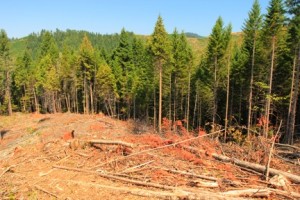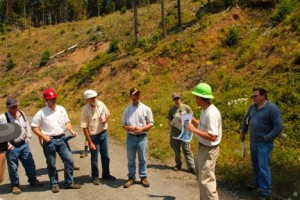By Rory Isbell, Cascadia Wildlands Legal Intern
Fellow intern Rance and I recently joined Cascadia Wildlands’ Conservation Director Francis Eatherington on a public tour of the Buck Rising timber sale on BLM land east of Myrtle Creek, Oregon. The tour was organized by the BLM Roseburg District office in order to demonstrate the results of the timber sale and gain feedback from the public. Officially, the project is called the Buck Rising Variable Retention Regeneration Harvest (VRH), and is one of four demonstration projects currently underway on BLM lands in Western Oregon. The demonstration projects are mandated by the Secretary of the Interior in order to increase logging on O&C lands. The Buck Rising project was initially proposed and sold as a thinning project that would cut and harvest 60 year old trees originally planted as a plantation to accelerate the development of  late-successional habitat necessary to the survival of the Northern Spotted Owl – habitat now drastically underrepresented on public lands in Western Oregon. In order to appease political pressures for increased logging on O&C lands, however, the Buck Rising thinning project was re-sold as a secretarial demonstration project. The project’s silvicultural prescription, VRH, was developed by Drs. Johnson and Franklin, professors of forestry at Oregon State University.
late-successional habitat necessary to the survival of the Northern Spotted Owl – habitat now drastically underrepresented on public lands in Western Oregon. In order to appease political pressures for increased logging on O&C lands, however, the Buck Rising thinning project was re-sold as a secretarial demonstration project. The project’s silvicultural prescription, VRH, was developed by Drs. Johnson and Franklin, professors of forestry at Oregon State University.

Buck Rising unit 3, a clearcut by most definitions.
The BLM-hosted field tour provided a first look at the aftermath of a “variable retention regeneration harvest." Because Senator Ron Wyden’s O&C Bill utilizes the VRH method, and because all BLM districts in Western Oregon are considering the VRH method in the development of new Resource Management Plans that set the standards and guidelines for timber harvest in Oregon, the Buck Rising project is especially significant. The tour began by passing through a locked gate on adjacent private industrial forestry land and ascending to an overlook where all three units of the Buck Rising project are visible.
Questions immediately arose form the public regarding the Buck Rising project’s compliance with the Northwest Forest Plan and the current BLM Roseburg District Resource Management Plan. Those concerns came to a head upon crossing the boundary into unit three of the Buck Rising VRH.
While some clumps of trees were retained, most retention occurred in buffers along riparian areas. In non-riparian areas, only 10% of trees were retained. The BLM stresses the ecological benefits of early-successional habitat development, including flowers, nectars, fruits, and forage herbs for wildlife, and refuses to call the harvest a clearcut. Many concerned members of the public, however, noted the lack of snags and remnant dead wood necessary to healthy and natural early-successional habitat development. Cascadia Wildlands’ own Francis Eatherington continually noted how one of three BLM project objectives includes creating forage foliage for elk and deer, yet within a mile away on private  industrial timber land, timber companies recently petitioned ODFW for a public deer hunt in order to curb the abnormally high deer populations feeding on the omnipresent early-successional conditions on their post-clearcut plantations.
industrial timber land, timber companies recently petitioned ODFW for a public deer hunt in order to curb the abnormally high deer populations feeding on the omnipresent early-successional conditions on their post-clearcut plantations.

One of the tour stops was at a landslide in one of the Buck Rising logging units.
After lunch and a short drive to Buck Rising Unit 2, we saw the remnant debris of the slope failure event that occurred in February following timber harvest and heavy rains (https://www.cascwild.org/wyden-style-clearcut-causes-mudslide-on-oc-lands/).
By the end of a tour full of adversarial discussion, consensus was decisively lacking. Understanding, however, was plentiful. The concerned public understands the tough position that the Roseburg District BLM finds itself. While the Northwest Forest Plan calls for the restoration of the range of the Northern Spotted Owl by limiting timber harvest on federal lands, the O&C Act along with political pressures from Senator Wyden and the Department of the Interior call for increased timber harvest as a short term economic benefit. The BLM also understands that the concerned public wants tall, biodiverse forests on our public lands, and streams clear of sediment and full of salmon, and that we are dedicated to holding our public lands agencies accountable to those goals.
